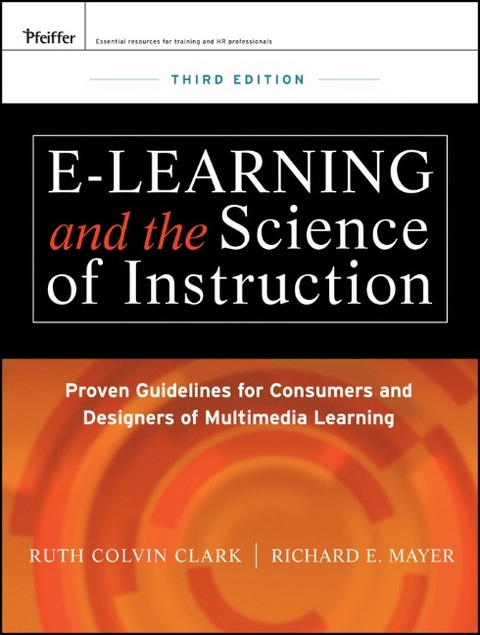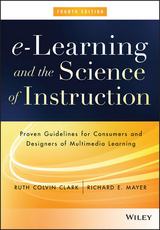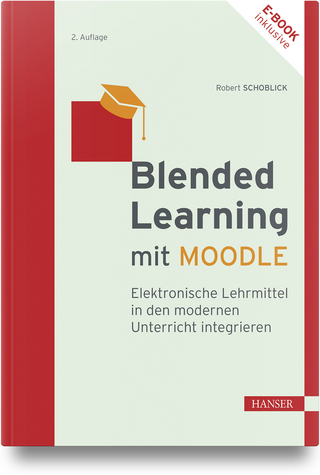
e-Learning and the Science of Instruction
John Wiley & Sons Ltd (Verlag)
978-0-470-87430-1 (ISBN)
- Titel ist leider vergriffen;
keine Neuauflage - Artikel merken
Thoroughly revised and updated, this third edition of the best-selling book offers a comprehensive review of multimedia learning for both users and designers. The book contains design principles that are written to increase learning while debunking many popular theories about good design. The book also contains the most current research and includes new topics (e-learning for educators, new delivery technologies, social media, and more) and offers helpful guidelines. The book s many examples: create working multimedia that inform the research guidelines; have been update to include real-world screen captures; extend principles to illustrate their application to synchronous e-learning tools.
Ruth Colvin Clark has worked for more than thirty years with instructional professionals assigned to design, develop, and select effective training for classroom or computer delivery. She is widely published in the areas of training, development, and performance improvement. Richard E. Mayer is professor of psychology at the University of California, Santa Barbara. He is an internationally-recognized expert in the application of learning psychology to design of instruction in multimedia learning environments, as well as the author of Multimedia Learning and the editor of the Cambridge Handbook of Multimedia Learning.
Acknowledgments xvii Introduction 1 1. e-Learning: Promise and Pitfalls 7 What Is e-Learning? 8 Is e-Learning Better? 11 The Promise of e-Learning 14 The Pitfalls of e-Learning 19 Inform and Perform e-Learning Goals 20 e-Learning Architectures 22 What Is Effective e-Courseware? 23 Learning in e-Learning 25 2. How Do People Learn from e-Courses? 29 How Do People Learn? 31 How e-Lessons Affect Human Learning 39 What We Don t Know About Learning 44 3. Evidence-Based Practice 49 What Is Evidence-Based Practice? 50 Three Approaches to Research on Instructional Effectiveness 51 What to Look for in Experimental Comparisons 55 How to Interpret No Effect in Experimental Comparisons 57 How to Interpret Research Statistics 58 How Can You Identify Relevant Research? 61 What We Don t Know About Evidence-Based Practice 62 4. Applying the Multimedia Principle: Use Words and Graphics Rather Than Words Alone 67 Do Visuals Make a Difference? 69 Multimedia Principle: Include Both Words and Graphics 70 Some Ways to Use Graphics to Promote Learning 74 Psychological Reasons for the Multimedia Principle 78 Evidence for Using Words and Pictures 79 The Multimedia Principle Works Best for Novices 83 Should You Change Static Illustrations into Animations? 84 What We Don t Know About Visuals 86 5. Applying the Contiguity Principle: Align Words to Corresponding Graphics 91 Contiguity Principle 1: Place Printed Words Near Corresponding Graphics 93 Contiguity Principle 2: Synchronize Spoken Words with Corresponding Graphics 102 Psychological Reasons for the Contiguity Principle 104 Evidence for Presenting Printed Words Near Corresponding Graphics 106 Evidence for Presenting Spoken Words at the Same Time as Corresponding Graphics 109 What We Don t Know About Contiguity 110 6. Applying the Modality Principle: Present Words as Audio Narration Rather Than On-Screen Text 115 Modality Principle: Present Words as Speech Rather Than On-Screen Text 117 Limitations to the Modality Principle 119 Psychological Reasons for the Modality Principle 121 Evidence for Using Spoken Rather Than Printed Text 123 When the Modality Principle Applies 128 What We Don t Know About Modality 129 7. Applying the Redundancy Principle: Explain Visuals with Words in Audio OR Text: Not Both 133 Redundancy Principle 1: Do Not Add On-Screen Text to Narrated Graphics 135 Psychological Reasons for the Redundancy Principle 137 Evidence for Omitting Redundant On-Screen Text 139 Redundancy Principle 2: Consider Adding On-Screen Text to Narration in Special Situations 141 Psychological Reasons for Exceptions to the Redundancy Principle 142 Evidence for Including Redundant On-Screen Text 144 What We Don t Know About Redundancy 146 8. Applying the Coherence Principle: Adding Material Can Hurt Learning 151 Coherence Principle 1: Avoid e-Lessons with Extraneous Audio 153 Psychological Reasons to Avoid Extraneous Audio in e-Learning 156 Evidence for Omitting Extraneous Audio 157 Coherence Principle 2: Avoid e-Lessons with Extraneous Graphics 159 Psychological Reasons to Avoid Extraneous Graphics in e-Learning 160 Evidence for Omitting Extraneous Graphics Added for Interest 161 Evidence for Using Simpler Visuals 164 Coherence Principle 3: Avoid e-Lessons with Extraneous Words 166 Psychological Reasons to Avoid Extraneous Words in e-Learning 168 Evidence for Omitting Extraneous Words Added for Interest 168 Evidence for Omitting Extraneous Words Added to Expand on Key Ideas 170 Evidence for Omitting Extraneous Words Added for Technical Depth 172 What We Don t Know About Coherence 172 9. Applying the Personalization Principle: Use Conversational Style and Virtual Coaches 179 Personalization Principle 1: Use Conversational Rather Than Formal Style 182 Psychological Reasons for the Personalization Principle 183 Evidence for Using Conversational Style 185 Promote Personalization Through Voice Quality 188 Promote Personalization Through Polite Speech 189 Personalization Principle 2: Use Effective On-Screen Coaches to Promote Learning 191 Personalization Principle 3: Make the Author Visible to Promote Learning 197 Psychological Reasons for Using a Visible Author 200 Evidence for the Visible Author 200 What We Don t Know About Personalization 201 10. Applying the Segmenting and Pretraining Principles: Managing Complexity by Breaking a Lesson into Parts 205 Segmenting Principle: Break a Continuous Lesson into Bite-Size Segments 207 Psychological Reasons for the Segmenting Principle 210 Evidence for Breaking a Continuous Lesson into Bite-Size Segments 211 Pretraining Principle: Ensure That Learners Know the Names and Characteristics of Key Concepts 212 Psychological Reasons for the Pretraining Principle 214 Evidence for Providing Pretraining in Key Concepts 216 What We Don t Know About Segmenting and Pretraining 218 11. Leveraging Examples in e-Learning 223 What Are Worked Examples? 224 The Psychology of Worked Examples 227 Evidence for the Benefi ts of Worked Examples 227 Worked Example Principle 1: Fade from Worked Examples to Problems 229 Worked Example Principle 2: Promote Self-Explanations 231 Worked Example Principle 3: Include Instructional Explanations of Worked Examples in Some Situations 234 Worked Example Principle 4: Apply Multimedia Principles to Examples 235 Worked Example Principle 5: Support Learning Transfer 239 Design Guidelines for Far Transfer Worked Examples 240 What We Don t Know About Worked Examples 245 12. Does Practice Make Perfect? 251 What Is Practice in e-Learning? 253 The Paradox of Practice 255 Practice Principle 1: Add Suffi cient Practice Interactions to e-Learning to Achieve the Objective 257 Practice Principle 2: Mirror the Job 262 Practice Principle 3: Provide Effective Feedback 263 Practice Principle 4: Distribute and Mix Practice Among Learning Events 267 Practice Principle 5: Apply Multimedia Principles 272 Practice Principle 6: Transition from Examples to Practice Gradually 274 What We Don t Know About Practice 274 13. Learning Together Virtually 279 What Is Collaborative Learning? 280 What Is Computer-Supported Collaborative Learning (CSCL)? 284 Some Generalizations About Collaboration 288 CSCL Research Summaries 292 Structured Controversy 300 CSCL: The Bottom Line 303 What We Don t Know About CSCL 303 14. Who s in Control? Guidelines for e-Learning Navigation 309 Learner Control Versus Program Control 311 Do Learners Make Good Instructional Decisions? 315 Learner Control Principle 1: Give Experienced Learners Control 319 Learner Control Principle 2: Make Important Instructional Events the Default 322 Learner Control Principle 3: Consider Adaptive Control 323 Learner Control Principle 4: Give Pacing Control 327 Learner Control Principle 5: Offer Navigational Support in Hypermedia Environments 329 What We Don t Know About Learner Control 333 15. e-Learning to Build Thinking Skills 339 Three Types of Thinking Skills 341 Can Thinking Skills Be Trained? 343 Thinking Skills Principle 1: Focus on Job-Specific Cognitive and Metacognitive Skills 344 Thinking Skills Principle 2: Consider a Whole-Task Course Design 345 Evidence for Whole-Task Instruction 351 Thinking Skills Principle 3: Make Thinking Processes Explicit 355 Thinking Skills Principle 4: Defi ne Job-Specifi c Thinking Processes 360 Teaching Thinking Skills: The Bottom Line 363 What We Don t Know About Teaching Thinking Skills 364 16. Simulations and Games in e-Learning 369 The Case for Simulations and Games 372 What Are Simulations and Games? 374 Do Games and Simulations Teach? 378 Games and Simulations Principle 1: Match Game Types to Learning Goals 381 Games and Simulations Principle 2: Make Learning Essential to Game Progress 382 Games and Simulations Principle 3: Build in Proven Instructional Strategies 382 Games and Simulations Principle 4: Build in Guidance and Structure 386 Games and Simulations Principle 5: Manage Complexity 389 Games and Simulations Principle 6: Make Relevance Salient 393 What We Don t Know About Games and Simulations 394 17. Applying the Guidelines 401 Applying Evidence-Based Guidelines to e-Courses 401 e-Lesson Reviews 404 Review of Sample 1: Asynchronous e-Lesson on Excel for Small Business 409 Review of Sample 2: Synchronous e-Lesson on Excel 414 Review of Sample 3: Automotive Troubleshooting Simulation 418 Reflections on Past Predictions 421 Beyond 2011 423 In Conclusion 424 References 425 Glossary 453 List of Tables and Figures 475 Name Index 487 Subject Index 493 About the Authors 501 Pfeiffer Publications Guide 503
| Zusatzinfo | ill |
|---|---|
| Verlagsort | Chichester |
| Sprache | englisch |
| Maße | 186 x 247 mm |
| Gewicht | 986 g |
| Themenwelt | Schulbuch / Wörterbuch ► Unterrichtsvorbereitung ► Unterrichts-Handreichungen |
| Sozialwissenschaften ► Pädagogik ► Berufspädagogik | |
| Wirtschaft ► Betriebswirtschaft / Management ► Personalwesen | |
| ISBN-10 | 0-470-87430-9 / 0470874309 |
| ISBN-13 | 978-0-470-87430-1 / 9780470874301 |
| Zustand | Neuware |
| Haben Sie eine Frage zum Produkt? |
aus dem Bereich



